会计学主要知识点英文
会计英语分录知识点总结
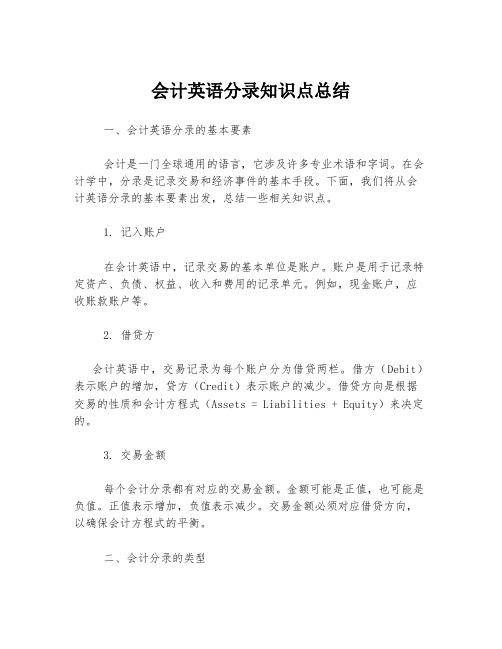
会计英语分录知识点总结一、会计英语分录的基本要素会计是一门全球通用的语言,它涉及许多专业术语和字词。
在会计学中,分录是记录交易和经济事件的基本手段。
下面,我们将从会计英语分录的基本要素出发,总结一些相关知识点。
1. 记入账户在会计英语中,记录交易的基本单位是账户。
账户是用于记录特定资产、负债、权益、收入和费用的记录单元。
例如,现金账户,应收账款账户等。
2. 借贷方会计英语中,交易记录为每个账户分为借贷两栏。
借方(Debit)表示账户的增加,贷方(Credit)表示账户的减少。
借贷方向是根据交易的性质和会计方程式(Assets = Liabilities + Equity)来决定的。
3. 交易金额每个会计分录都有对应的交易金额。
金额可能是正值,也可能是负值。
正值表示增加,负值表示减少。
交易金额必须对应借贷方向,以确保会计方程式的平衡。
二、会计分录的类型会计分录可以分为多种类型,如收入分录、费用分录、资产分录和负债分录。
以下是这些类型的简要介绍:1. 收入分录收入分录用于记录企业的销售收入或其他经济利益的增加。
例如,当企业出售产品或提供服务时,相关的收入分录会以增加负债的方式进行。
2. 费用分录费用分录用于记录企业的成本或其他经济利益的减少。
例如,当企业支付员工工资或采购原材料时,相关的费用分录会以增加负债的方式进行。
3. 资产分录资产分录用于记录企业的资产增加。
例如,当企业购买设备或现金流入时,相关的资产分录会以增加资产的方式进行。
4. 负债分录负债分录用于记录企业的负债增加。
例如,当企业借款或向供应商付款时,相关的负债分录会以增加负债的方式进行。
三、常见的会计英语分录术语除了基本要素和类型外,会计英语中还涉及许多特定的术语。
以下是一些常见的会计术语:1. 现金收入(Cash Receipts)指通过现金或支票等形式收到的款项或收入。
2. 现金支出(Cash Disbursements)指以现金或支票等形式支付的款项或费用。
会计英文词汇大全
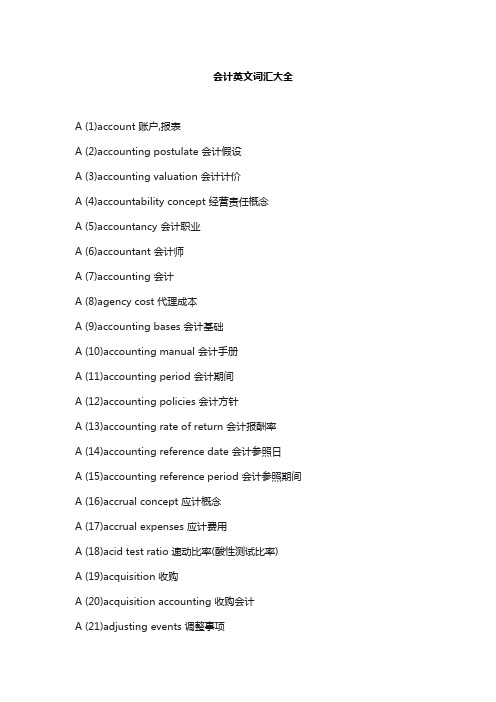
会计英文词汇大全A (1)account 账户,报表A (2)accounting postulate 会计假设A (3)accounting valuation 会计计价A (4)accountability concept 经营责任概念A (5)accountancy 会计职业A (6)accountant 会计师A (7)accounting 会计A (8)agency cost 代理成本A (9)accounting bases 会计基础A (10)accounting manual 会计手册A (11)accounting period 会计期间A (12)accounting policies 会计方针A (13)accounting rate of return 会计报酬率A (14)accounting reference date 会计参照日A (15)accounting reference period 会计参照期间A (16)accrual concept 应计概念A (17)accrual expenses 应计费用A (18)acid test ratio 速动比率(酸性测试比率)A (19)acquisition 收购A (20)acquisition accounting 收购会计A (21)adjusting events 调整事项A (22)administrative expenses 行政管理费A (23)amortization 摊销A (24)analytical review 分析性复核A (25)annual equivalent cost 年度等量成本法A (26)annual report and accounts 年度报告和报表A (27)appraisal cost 检验成本A (28)appropriation account 盈余分配账户A (29)articles of association 公司章程细则A (30)assets 资产A (31)assets cover 资产担保A (32)asset value per share 每股资产价值A (33)associated company 联营公司A (34)attainable standard 可达标准A (35)attributable profit 可归属利润A (36)audit 审计A (37)audit report 审计报告A (38)auditing standards 审计准则A (39)authorized share capital 额定股本A (40)available hours 可用小时A (41)avoidable costs 可避免成本B (42)back-to-back loan 易币贷款B (43)backflush accounting 倒退成本计算B (44)bad debts 坏帐B (45)bad debts ratio 坏帐比率B (46)bank charges 银行手续费B (47)bank overdraft 银行透支B (48)bank reconciliation 银行存款调节表B (49)bank statement 银行对账单B (50)bankruptcy 破产B (51)basis of apportionment 分摊基础B (52)batch 批量B (53)batch costing 分批成本计算B (54)beta factor B (市场)风险因素BB (55)bill 账单B (56)bill of exchange 汇票B (57)bill of lading 提单B (58)bill of materials 用料预计单B (59)bill payable 应付票据B (60)bill receivable 应收票据B (61)bin card 存货记录卡B (62)bonus 红利B (63)book-keeping 薄记B (64)Boston classification 波士顿分类B (65)breakeven chart 保本图B (66)breakeven point 保本点B (67)breaking-down time 复位时间B (68)budget 预算B (69)budget center 预算中心B (70)budget cost allowance 预算成本折让B (71)budget manual 预算手册B (72)budget period 预算期间B (73)budgetary control 预算控制B (74)budgeted capacity 预算生产能力B (75)business center 经营中心B (76)business entity 营业个体B (77)business unit 经营单位B (78)by-product 副产品C (79)called-up share capital 催缴股本C (80)capacity 生产能力C (81)capacity ratios 生产能力比率C (82)capital 资本C (83)capital assets pricing model 资本资产计价模式C (84)capital commitment 承诺资本C (85)capital employed 已运用的资本C (86)capital expenditure 资本支出C (87)capital expenditure authorization 资本支出核准C (88)capital expenditure control 资本支出控制C (89)capital expenditure proposal 资本支出申请C (90)capital funding planning 资本基金筹集计划C (91)capital gain 资本收益C (92)capital investment appraisal 资本投资评估C (93)capital maintenance 资本保全C (94)capital resource planning 资本资源计划C (95)capital surplus 资本盈余C (96)capital turnover 资本周转率C (97)card 记录卡C (98)cash 现金C (99)cash account 现金账户C (100)cash book 现金账薄C (101)cash cow 金牛产品C (102)cash flow 现金流量C (103)cash flow budget 现金流量预算C (104)cash flow statement 现金流量表C (105)cash ledger 现金分类账C (106)cash limit 现金限额C (107)CCA 现时成本会计C (108)center 中心C (109)changeover time 变更时间C (110)chartered entity 特许经济个体C (111)cheque 支票C (112)cheque register 支票登记薄C (113)classification 分类C (114)clock card 工时卡C (115)code 代码C (116)commitment accounting 承诺确认会计C (117)common cost 共同成本C (118)company limited by guarantee 有限担保责任公司C (119)company limited by shares 股份有限公司C (120)competitive position 竞争能力状况C (121)concept 概念C (122)conglomerate 跨行业企业C (123)consistency concept 一致性概念C (124)consolidated accounts 合并报表C (125)consolidation accounting 合并会计C (126)consortium 财团C (127)contingency plan 应急计划C (128)contingent liabilities 或有负债C (129)continuous operation 连续生产C (130)contra 抵消C (131)contract cost 合同成本C (132)contract costing 合同成本计算C (133)contribution centre 贡献中心C (134)contribution chart 贡献图C (135)control 控制C (136)control account 控制账户C (137)control limits 控制限度C (138)controllability concept 可控制概念C (139)controllable cost 可控制成本C (140)conversion cost 加工成本C (141)convertible loan stock 可转换为股票的贷款C (142)corporate appraisal 公司评估C (143)corporate planning 公司计划C (144)corporate social reporting 公司社会报告C (145)cost 成本C (146)cost account 成本账户C (147)cost accounting 成本会计C (148)cost accounting manual 成本手册C (149)cost adjustment 成本调整C (150)cost allocation 成本分配C (151)cost apportionment 成本分摊C (152)cost attribution 成本归属C (153)cost audit 成本审计C (154)cost benefit analysis 成本效益分析C (155)cost center 成本中心C (156)cost driver 成本动因C (157)cost of capital 资本成本C (158)cost of goods sold 销货成本C (159)cost of non-conformance 非相符成本C (160)cost of sales 销售成本C (161)cost reduction 成本降低C (162)cost structure 成本结构C (163)cost unit 成本单位C (164)cost-volume-profit analysis(CVP) 本量利分析C (165)costing 成本计算C (166)credit note 贷项通知C (167)credit report 信贷报告书C (168)creditor 债权人C (169)creditor days ratio 应付账款天数率C (170)creditors ledger 应付账款分类账C (171)critical event 关键事项C (172)critical path 关键路线C (173)cumulative preference shares 累积优先股C (174)current asset 流动资产C (175)current cost accounting 现时成本会计C (176)current liabilities 流动负债C (177)current purchasing power accounting 现时购买力会计C (178)current ratio 流动比率C (179)cut-off 截止C (180)CVP 本量利分析C (181)cycle time 周转时间D (182)debenture 债券D (183)debit note 借项通知D (184)debit capacity 举债能力D (185)debt ratio 债务比率D (186)debtor 债务人;应收账款D (187)debtor days ratio 应收账款天数率D (188)debtors ledger 应收账款分类账D (189)debtor' age analysis 应收账款账龄分析D (190)decision driven costs 决策连动成本D (191)decision tree 决策树D (192)defects 次品D (193)deferred expenditure 递延支出D (194)deferred shares 递延股份D (195)deferred taxation 递延税款D (196)delivery note 交货单D (197)departmental accounts 部门报表D (198)departmental budget 部门预算D (199)depreciation 折旧D (200)dispatch note 发运单D (201)development cost 开发成本D (202)differential cost 差别成本D (203)direct cost 直接成本D (204)direct debit 直接借项D (205)direct hours yield 直接小时产出率D (206)direct labour cost percentage rate 直接人工成本百分比D (207)direct labour hour rate 直接人工小时率D (208)directs on indirect work 间接工作事项上的工时D (209)discount rate 贴现率D (210)discounted cash flow 现金流量贴现D (211)discretionary cost 酌量成本D (212)distribution cost 摊销成本D (213)diversions 移用D (214)diverted hours 移用小时D (215)diverted hours ratio 移用工时比率D (216)dividend 股利D (217)dividend cover 股利产出率D (218)dividend per share 每股股利D (219)dog 疲软产品D (220)double entry accounting 复式会计D (221)double-entry book-keeping 复式薄记D (222)doubtful debts 可疑债务D (223)down time 停工时间D (224)dynamic programming 动态规划E (225)earning per share 每股盈利E (226)earning ratio 市盈率E (227)economic order quantity(EOQ) 经济订购批量E (228)efficient market hypothesis 有效市场假设E (229)efficiency ration 效率性比率E (230)element of cost 成本要素E (231)entity 经济个体E (232)environmental audit 环境审计E (233)environmental impact assessment 环境影响评价E (234)EOQ 经济订购批量E (235)equity 权益E (236)equity method of accounting 权益法会计计算E (237)equity share capital 权益股本E (238)equivalent units 当量E (239)event 事项E (240)exceptional items 例外事项E (241)expected value 期望值E (242)expenditure 支出E (243)expenses 费用E (244)external audit 外部审计E (245)external failure cost 外部损失成本E (246)extraordinary items 非常事项F (247)factory goods 让售商品F (248)factoring 应收帐款让售F (249)fair value 公允价值F (250)feedback 反馈F (251)FIFO 先近先出法F (252)final accounts 年终报表F (253)finance lease 融资租赁F (254)financial accounting 财务会计F (255)financial accounts calendar adjustment 财务报表的日历时间调整F (256)financial management 财务管理F (257)financial planning 财务计划F (258)financial statement 财务报表F (259)finished goods 完成品F (260)fixed asset 固定资产F (261)fixed overhead 固定制造费用F (262)fixed asset turnover 固定资产周转率F (263)fixed assets register 固定资产登记薄F (264)fixed cost 固定成本F (265)flexed budget 变动限额预算F (266)flexible budget 弹性预算F (267)float time 浮动时间F (268)floating charge 流动抵押F (269)flow of funds statement 资金流量表F (270)forecasting 预测F (271)founder's shares 发起人股份F (272)full capacity 满负荷生产能力F (273)function costing 职能成本计算F (274)functional budget 职能预算F (275)fund accounting 基金会计F (276)fundamental accounting concept 基础会计概念F (277)fungible assets 可互换资产F (278)futuristic planning 远景计划G (279)gap analysis 间距分析G (280)gearing 举债经营比率(杠杆)G (281)goal congruence 目标一致性G (282)going concern concept 持续经营概念G (283)goods received note 商品收讫单G (284)goodwill 商誉G (285)gross dividend yield 总股息产出率G (286)gross margin 总边际G (287)gross profit 毛利润G (288)gross profit percentage 毛利润百分比G (289)group 企业集团G (290)group accounts 集团报表H (291)high-geared 高结合杠杆(比例)H (292)hire purchase 租购H (293)historical cost 历史成本H (294)historical cost accounting 历史成本会计H (295)hours 小时H (296)hurdle rate 最低可接受的报酬率I (297)ideal standard 理想标准I (298)idle capacity ration 闲置生产能力比率I (299)idle time 闲置时间I (300)impersonal accounts 非记名账户I (301)imprest system 定额备用制度I (302)income and expenditure account 收益和支出报表I (303)incomplete records 不完善记录I (304)incremental cost 增量成本I (305)incremental yield 增量产出率I (306)indirect cost 间接成本I (307)indirect hours 间接小时I (308)insolvency 无力偿付I (309)intangible asset 无形资产I (310)integrated accounts 综合报表I (311)interdependency concept 关联性概念I (312)interest cover 利息保障倍数I (313)interlocking accounts 连锁报表I (314)internal audit 内部审计I (315)internal check 内部牵制I (316)internal control system 内部控制体系I (317)internal failure cost 内部损失成本I (318)internal rate of return(IRR) 内含报酬率I (319)inventory 存货I (320)investment 投资I (321)investment center 投资中心I (322)invoice register 发票登记薄I (323)issued share capital 已发行股本J (324)job 定单J (325)job card 工作卡J (326)job costing 工作成本计算J (327)job sheet 工作单J (328)joint cost 联合成本J (329)joint products 联产品J (330)joint stock company 股份公司J (331)joint venture 合资经营J (332)journal 日记账J (333)just-in-time(JIT) 适时制度J (334)just-in-time production 适时生产J (335)just-in-time purchasing 适时购买K (336)key factor 关键因素L (337)labour 人工L (338)labour transfer note 人工转移单L (339)leaning curve 学习曲线L (340)ledger 分类账户L (341)length of order book 定单平均周期L (342)letter of credit 信用证L (343)leverage 举债经营比率L (344)liabilities 负债L (345)life cycle costing 寿命周期成本计算L (346)LIFO 后近先出法L (347)limited liability company 有限责任公司L (348)limiting factor 限制因素L (349)line-item budget 明细支出预算L (350)liner programming 线性规划L (351)liquid assets 变现资产L (352)liquidation 清算L (353)liquidity ratios 易变现比率L (354)loan 贷款L (355)loan capital 借入资本L (356)long range planning 长期计划L (357)lost time record 虚耗时间记录L (358)low geared 低结合杠杆(比例)L (359)lower of cost or net realizable value concept 成本或可变净价孰低概念M (360)machine hour rate 机器小时率M (361)machine time record 机器时间记录M (362)managed cost 管理成本M (363)management accounting 管理会计M (364)management accounting concept 管理会计概念M (365)management accounting guides 管理会计指导方针M (366)management audit 管理审计M (367)management buy-out 管理性购买产权M (368)management by exception 例外管理原则M (369)margin 边际M (370)margin of safety ration 安全边际比率M (371)margin cost 边际成本M (372)margin costing 边际成本计算M (373)mark-down 降低标价M (374)mark-up 提高标价M (375)market risk premium 市场分险补偿M (376)market share 市场份额M (377)marketing cost 营销成本M (378)matching concept 配比概念M (379)materiality concept 重要性概念M (380)materials requisition 领料单M (381)materials returned note 退料单M (382)materials transfer note 材料转移单M (383)memorandum of association 公司设立细则M (384)merger 兼并M (385)merger accounting 兼并会计M (386)minority interest 少数股权M (387)mixed cost 混合成本N (388)net assets 净资产N (389)net book value 净账面价值N (390)net liquid funds 净可变现资金N (391)net margin 净边际N (392)net present value(NPV) 净现值N (393)net profit 净利润N (394)net realizable value 可变现净值N (395)net worth 资产净值N (396)network analysis 网络分析N (397)noise 干捞N (398)nominal account 名义账户N (399)nominal share capital 名义股本N (400)nominal holding 代理持有股份N (401)non-adjusting events 非调整事项N (402)non-financial performance measurement 非财务业绩计量N (403)non-integrated accounts 非综合报表N (404)non-liner programming 非线性规划N (405)non-voting shares 无表决权的股份N (406)notional cost 名义成本N (407)number of days stock 存货周转天数N (408)number of weeks stock 存货周转周数O (409)objective classification 客体分类O (410)obsolescence 陈旧O (411)off balance sheet finance 资产负债表外筹资O (412)offer for sale 标价出售O (413)operating budget 经营预算O (414)operating lease 经营租赁O (415)operating statement 营业报表O (416)operation time 操作时间O (417)operational control 经营控制O (418)operational gearing 经营杠杆O (419)operating plans 经营计划O (420)opportunity cost 机会成本O (421)order 定单O (422)ordinary shares 普通股O (423)out-of-date cheque 过期支票O (424)over capitalization 过分资本化O (425)overhead 制造费用O (426)overhead absorption rate 制造费用分配率O (427)overhead cost 制造费用O (428)overtrading 超过营业资金的经营P (429)paid cheque 已付支票P (430)paid-up share capital 认定股本P (431)parent company 母公司P (432)pareto distribution 帕累托分布P (433)participating preference shares 参与优先股P (434)partnership 合伙P (435)payable ledger 应付款项账户P (436)payback 回收期P (437)payments and receipts account 收入和支出报表P (438)payments withheld 保留款额P (439)payroll 工资单P (440)payroll analysis 工资分析P (441)percentage profit on turnover 利润对营业额比率P (442)period cost 期间成本P (443)perpetual inventory 永续盘存P (444)personal account 记名账户P (445)PEPT 项目评审法P (446)petty cash account 备用金账户P (447)petty cash voucher 备用金凭证P (448)physical inventory 实地盘存P (449)planning 计划P (450)planning horizon 计划时限P (451)planning period 计划期间P (452)policy cost 政策成本P (453)position audit 状况审计P (454)post balance sheet events 资产负债表编后事项P (455)practical capacity 实际生产能力P (456)pre-acquisition losses 购置前损失P (457)pre-acquisition profits 购置前利润P (458)preference shares 优先股P (459)preference creditors 优先债权人P (460)preferred creditors 优先债权人P (461)prepayments 预付款项P (462)present value 现值P (463)prevention cost 预防成本P (464)price ratio 市盈率P (465)prime cost 主要成本P (466)prime entry-books of 原始分录登记薄P (467)principal budget factor 主要预算因素P (468)prior charge capital 优先股P (469)prior year adjustments 以前年度调整P (470)priority base budgeting 优先顺序体制的预算P (471)private company 私人公司P (472)pro-forma invoice 预开发票P (473)problem child 问号产品P (474)process costing 分步成本计算P (475)process time 加工时间P (476)product cost 产品成本P (477)Product life cycle 产品寿命周期P (478)production cost 生产成本P (479)production cost of sales 售货成本P (480)production volume ratio 生产业务量比率P (481)profit center 利润中心P (482)profit per employee 每员工利润P (483)profit retained for the year 年度利润留存P (484)profit to turnover ratio 利润对营业额比率P (485)profit-volume graph 利量图P (486)profitability index 盈利指数P (487)programming 规划P (488)project evaluation and review technique 项目评审法P (489)projection 预计P (490)promissory note 本票P (491)prospectus 募债说明书P (492)provisions for liabilities and charges 偿债和费用准备P (493)prudent concept 稳健性概念P (494)public company 公开公司P (495)purchase order 订购单P (496)purchase requisition 请购单P (497)purchase ledger 采购账户Q (498)quality related costs 质量有关成本Q (499)queuing time 排队时间R (500)rate 率R (501)ratio 比率R (502)ration pyramid 比率金字塔R (503)raw material 原材料R (504)receipts and payments account 收入和支付报表R (505)receivable ledger 应收款项账户R (506)redeemable shares 可赎回股份R (507)redemption 赎回R (508)registered share capital 注册资本R (509)rejects 废品R (510)relevancy concept 相关性概念R (511)relevant costs 相关成本R (512)relevant range 相关范围R (513)reliability concept 可靠性概念R (514)replacement price 重置价格R (515)report 报表R (516)reporting 报告R (517)research cost, applied 应用性研究成本R (518)research cost, pure or basic 理论或基础研究成本R (519)reserves 留存收益R (520)residual income 剩余收益R (521)responsibility center 责任中心R (522)retention money 保留款额R (523)return on capital employed 运用资本报酬率R (524)returns 退回R (525)revenue 收入R (526)revenue center 收入中心R (527)revenue expenditure 收益支出R (528)revenue investment 收入性投资R (529)right issue 认股权发行R (530)rolling budget 滚动预算R (531)rolling forecast 滚动预测S (532)sales ledger 销售分类账S (533)sales order 销售定单S (534)sales per employee 每员工销售额S (535)scrap 废料S (536)scrip issue 红股发行S (537)secured creditors 有担保的债权人S (538)segmental reporting 分部报告S (539)selling cost 销售成本S (540)semi-fixed cost 半固定成本S (541)semi-variable cost 半变动成本S (542)sensitivity analysis 敏感性分析S (543)service cost center 服务成本中心S (544)service costing 服务成本计算S (545)set-up time 安装时间S (546)shadow prices 影子价格S (547)share 股票S (548)share capital 股份资本S (549)share option scheme 购股权证方案S (550)share premium 股票溢价S (551)sight draft 即期汇票S (552)single-entry book-keeping 单式薄记S (553)sinking fund 偿债基金S (554)slack time 松弛时间S (555)social responsibility cost 社会责任成本S (556)sole trader 独资经营者S (557)source and application of funds statement 资金来源和运用表S (558)special order costing 特殊定单成本计算S (559)staff costs 职工成本S (560)statement of account 营业账单S (561)statement of affairs 财务状况表S (562)statutory body 法定实体S (563)stock 存货S (564)stock control 存货控制S (565)stock turnover 存货周转率S (566)stocktaking 盘点存货S (567)stores requisition 领料申请单S (568)strategic business unit 战略性经营单位S (569)strategic management accounting 战略管理会计S (570)strategic planning 战略计划S (571)strategy 战略S (572)subjective classification 主体分类S (573)subscribed share capital 已认购的股本S (574)subsidiary undertaking 子公司S (575)sunk cost 沉没成本S (576)supply estimate 预算估计S (577)supply expenditure 预算支出S (578)suspense account 暂记账户S (579)SWOT analysis 长处和短处,机会和威胁分析S (580)system 制度,体系T (581)tactical planning 策略计划T (582)tactics 策略T (583)take-over 接收T (584)tangible asset 有形资产T (585)tangible fixed asset statement 有形固定资产表T (586)target cost 目标成本T (587)terotechnology 设备综合工程学T (588)throughput accounting 生产量会计T (589)time 时间T (590)time sheet 时间记录表T (591)total assets 总资产T (592)total quality management 全面质量管理T (593)total stocks 存货总计T (594)trade creditors 购货客户(应付账款)T (595)trade debtors 销货客户(应收账款)T (596)trading profit and loss account 营业损益表T (597)transfer price 转让价格T (598)transit time 中转时间T (599)treasurership 财务长制度T (600)trail balance 试算平衡表T (601)turnover 营业额U (602)uncalled share capital 未催缴股本U (603)under capitalization 不足资本化U (604)under or over-absorbed overhead 少吸收或多吸收的制造费用U (605)uniform accounting 统一会计U (606)uniform costing 统一成本计算U (607)unissued share capital 未发行股本V (608)value 价值V (609)value added 增值V (610)value analysis 价值分析V (611)value for money audit 经济效益审计V (612)vote 表决V (613)voucher 凭证W (614)waiting time 等候时间W (615)waste 废品(料)W (616)wasting asset 递耗资产W (617)weighted average cost of capital 资本的加权平均成本W (618)weighted average price 加权平均价格W (619)with resource 有追索权W (620)without recourse 无追索权W (621)working capital 营运资本W (622)write-down 减值Z (623)zero base budgeting 零基预算Z (624)zero coupon bond 无息债券Z (625)Z score 破产预测计分法。
会计学英语专业知识点

会计学英语专业知识点会计学英语是会计专业的一门重要课程,通过学习会计学英语,学生可以了解并掌握相关的会计学知识,提升自己的专业能力。
本文将介绍一些常见的,并探讨其应用。
一、基本概念和原则1. 会计学(Accounting)会计学是研究经济事务,以及记录、报告和分析经济事务的过程和方法的学科。
2. 会计信息(Accounting Information)会计信息是通过会计系统从经济事务中提取、记录、报告和分析的信息。
3. 会计方程式(Accounting Equation)会计方程式是会计记录的核心,它表达了资产、负债和所有者权益之间的关系,即:资产 = 负债 + 所有者权益4. 会计准则(Accounting Standards)会计准则是用来规范和统一会计信息记录、报告和分析的规则和原则。
二、会计报表1. 资产负债表(Balance Sheet)资产负债表是会计报表中的一种,用来反映企业在特定日期的财务状况,即企业的资产、负债和净资产。
2. 损益表(Income Statement)损益表是会计报表中的一种,用来反映企业在特定期间内的经营成果,即企业的收入、费用和利润。
3. 现金流量表(Cash Flow Statement)现金流量表是会计报表中的一种,用来反映企业在特定期间内现金流入和流出的情况,即企业的经营、投资和筹资活动。
4. 所有者权益变动表(Statement of Changes in Equity)所有者权益变动表是会计报表中的一种,用来反映企业在特定期间内所有者权益的变化情况,即企业的净资产组成和变动。
三、会计要素1. 资产(Assets)资产是企业拥有的经济资源,可以被用来创造经济利益。
2. 负债(Liabilities)负债是企业对外部经济资源的债务或义务,需要偿还给债权人。
3. 所有者权益(Owner's Equity)所有者权益是企业对所有者的经济利益,包括资本、留存收益和其他权益。
100个财务知识点总结

100个财务知识点总结财务知识是每个人都应该具备的一种知识,不管是经营企业还是个人理财,都离不开财务知识。
财务知识包括会计知识、投资理财知识、税收知识等等。
以下是总结的100个财务知识点,希望对大家有所帮助。
一、会计知识1. 会计基本方程式:资产=负债+所有者权益2. 账户的借贷方向:资产、费用类账户借方增加,负债、所有者权益、收入类账户贷方增加3. 资产负债表的基本结构:资产、负债、所有者权益4. 损益表的基本结构:收入、费用、利润5. 会计分录的编制方法:先分析交易,然后确定账户,再编制分录6. 会计科目的分类:资产、负债、所有者权益、收入、费用7. 会计凭证的种类:原始凭证、核算凭证、传票凭证8. 会计核算的基本步骤:收集原始凭证、核算业务、编制账户、编制财务报表9. 财务报表的类型:资产负债表、利润表、现金流量表10. 会计核算的基本原则:实体企业独立性原则、持续经营原则、货币计量原则二、税收知识11. 个人所得税的基本纳税对象:中国公民和外国个人12. 企业所得税的基本税率:15%13. 增值税的基本纳税对象:增值税一般纳税人14. 增值税的基本税率:一般税率17%,特殊税率11%、6%、3%15. 营业税的征收对象:从事生产、经营、服务等经营活动的单位和个人16. 房产税的基本计税依据:房屋面积、数量、标准、用途等因素17. 车辆购置税的计税对象:购买机动车的个人和单位18. 关税种类:一般关税、特别关税、反倾销税、反补贴税、特别保护性关税19. 个人财产税的纳税对象:个人财产的所有者三、投资理财知识20. 投资的基本原则:高风险、高收益、低风险、低收益21. 投资组合的构建原则:多样化、风险管理、长期投资22. 股票投资的基本原理:买入低价、卖出高价23. 基金投资的基本类型:股票基金、债券基金、混合基金、指数基金24. 固定收益投资的种类:国债、企业债、银行存款、债券基金25. 保险投资的种类:人寿保险、意外险、医疗保险、理财保险26. 黄金投资的基本形式:实物黄金、黄金ETF、黄金期货27. 房地产投资的基本方式:购买、出租、炒房、置换28. 外汇投资的基本原理:买入低汇率、卖出高汇率四、企业财务管理知识29. 财务预算的基本流程:制定预算、执行预算、检查预算、修订预算30. 资本预算的基本方法:净现值法、内部收益率法、投资回收期法31. 财务杠杆的种类:运营杠杆、财务杠杆、组织杠杆32. 企业财务决策的基本原则:高效利润、低成本、稳定现金流33. 公司财务风险的种类:市场风险、信用风险、流动性风险、操作风险34. 公司经营分析的方法:比率分析法、趋势分析法、财务体系分析法35. 公司融资的方式:银行贷款、股权融资、债券融资、项目融资36. 存货管理的方式:先进先出、后进先出、加权平均法37. 资金周转周期的计算方法:存货周转周期、应收账款周转周期、应付账款周转周期五、个人理财知识38. 收入与支出管理:收入-储蓄=支出39. 资产负债表的编制:资产总额-负债=净资产40. 个人现金流量表的编制:经营活动现金流+投资活动现金流+筹资活动现金流=期末现金余额41. 个人负债管理:不超过收入的50%42. 个人储蓄的方式:定期存款、活期存款、理财产品43. 个人投资的基本原理:多样化、分散风险、长期投资44. 个人保险规划:人身保险、财产保险、重大疾病保险45. 个人退休规划:养老金、个人储蓄、投资理财46. 个人税收规划:提前筹划、合理避税、利用税收优惠政策六、国际财务知识47. 国际结算的基本方式:信用证结算、托收结算、留汇结算48. 外汇市场的基本形式:现钞市场、远期市场、期货市场49. 国际贸易的货币种类:主要是美元、欧元和日元50. 国际金融市场的种类:外汇市场、贵金属市场、衍生品市场51. 国际财务报表的编制:美国通用会计准则、国际财务报告准则52. 国际税收规划:合理规避双重征税、避免税收逃避53. 跨国公司的资本结构:债权资本、股权资本、混合资本54. 跨国公司的资金运营:跨国资金结算、跨国融资、跨国投资七、财务风险管理知识55. 企业金融风险的种类:市场风险、信用风险、操作风险56. 企业金融风险的管理方法:风险预防、风险分散、风险控制57. 企业市场风险的认识方法:基本面分析、技术分析、事件分析58. 企业信用风险的防范措施:严格信贷管理、控制客户信用、分散风险59. 企业资金流动风险的应对方法:提前计划、合理预测、紧急融资60. 企业经营风险的应对措施:设立风险管理机构、建立风险管理框架、完善风险管理制度61. 个人投资风险的认知方法:风险与收益正相关、多样化投资、长期投资62. 个人信用风险的控制方法:及时还款、提高信用额度、节制消费八、财务管理职业素养63. 会计职业道德:诚实守信、保守职业秘密、独立性64. 会计师的基本职责:负责准备财务报告、财务顾问、税务筹划65. 会计师的基本能力:会计知识、财务管理、风险管理、人际沟通66. 财务主管的基本素质:财务知识、领导能力、沟通能力67. CFO的基本职责:财务管理、投资决策、融资决策68. CFO的基本素质:战略眼光、果断决策、风险管理69. 财务分析师的基本能力:数据分析、行业研究、财务建模70. 财务分析师的基本工作:财务报表分析、行业分析、公司估值九、财务法律知识71. 公司法的主要内容:公司的设立、组织机构、经营活动、公司治理72. 证券法的主要内容:股票、债券的发行、交易、信息披露73. 金融法的主要内容:金融机构的设立、监管、金融产品的发行、经营74. 税法的主要内容:税收的征收、管理、纳税义务人的权利和义务75. 合同法的主要内容:合同的订立、履行、变更、解除76. 融资租赁法的主要内容:融资租赁的定义、形式、权利义务77. 债权转让法律监管:债务人同意、登记备案、通知债务人78. 投资者权益保护法的主要内容:信息披露、市场操纵、内幕交易十、财务软件知识79. 会计软件的基本功能:记账、结算、报表分析、财务分析80. 财务报表软件的主要功能:报表设计、数据采集、报表分析、报表查询81. 财务管理软件的基本功能:预算编制、费用报销、资金计划、财务分析82. ERP系统的主要模块:供应链管理、生产计划、销售管理、财务管理83. 数据分析软件的基本功能:数据采集、数据处理、数据分析、数据报表84. 商业智能软件的作用:数据整合、业务分析、决策支持、执行管理85. 结算软件的种类:电子支付、网上银行、POS机收款、ATM机取款86. 电子票据软件的功能:票据制作、票据管理、票据查询十一、财务会计英语知识87. 财务报表的英文名称:Balance Sheet、Income Statement、Cash Flow Statement88. 会计报表的英文名称:Ledger、Journal、Trial Balance、Voucher89. 会计科目的英文名称:Assets、Liabilities、Equity、Revenue、Expense90. 会计核算的英文名称:Accounting Policy、Accounting Principle、Accounting Standard、Accounting Treatment91. 会计凭证的英文名称:Voucher、Receipt、Invoice、Statement92. 会计核算的英文名称:Double-entry bookkeeping、Accrual accounting、Cash-based accounting93. 会计分析的英文名称:Ratio analysis、Trend analysis、Financial system analysis94. 财务管理的英文名称:Financial Management、Budgeting、Investment Decision、Financing Decision十二、财务管理案例分析95. 财务报表分析的案例:利润表分析、资产负债表分析、现金流量表分析96. 资本预算的案例:投资项目分析、投资回收期计算、净现值计算97. 经营风险案例分析:市场风险、信用风险、流动性风险98. 融资决策案例:股权融资、债券融资、项目融资99. 财务危机案例分析:财务造假、资金链断裂、市场波动100. 财务创新案例分析:支付宝、京东金融、蚂蚁金服以上就是100个财务知识点总结,希望对大家有所帮助。
财务会计英语

1 2
利润表结构
利润表分为收入、成本费用和利润三个层次, 反映企业盈利能力。
解读利润表
通过利润表可以看出企业的盈利能力、经营效 率以及未来发展潜力。
3
编制利润表
按照会计准则要求,正确核算成本费用和利润 ,编制出符合规范的利润表。
05
财务分析
比率分析
含义
比率分析是一种财务报表分析 方法,通过计算比率来评估企
存货
预付款项
包括原材料、在产品、产成品等,涉及成本 计算、计价方法等。
核算企业预先支付的款项,如预付的材料款 、房租等。
非流动资产与负债的核算
固定资产
核算企业持有的固定资产原值、累计折旧 等,涉及折旧方法、减值准备等。
长期股权投资
核算企业长期持有股票、股权等投资的价 值和收益情况。
无形资产
核算企业的专利权、商标权等无形资产的 价值和摊销情况。
坚持准则
adhere to standards religiously
提高技能
improve skills continuously
会计职业道德教育与实践
会计职业道德教育的必要性 会计职业道德教育的途径与方法
会计职业道德教育的目标与内容 会计职业道德实践的意义与途径
THANKS
该课程主要面向高校会计专业学生、会计从业人员以及英语 爱好者,帮助他们掌握财务会计的基础理论和实践技能,并 能够熟练运用英语处理和解决实际问题。
学习目标
掌握财务会计的基本概念、理论、方法和实务。
能够阅读和理解财务会计英文文献、报告、报表 等资料。
提高英语听说读写能力,能够用英语进行基本的 财务会计业务沟通。
学习方法
系统学习
会计英语财务会计

目录分析
当我们翻开《会计英语财务会计》这本书时,首先映入眼帘的就是目录。目 录是一本书的导航图,它概括了书中的主题和章节,为读者提供了整体的概览。 因此,对于想要深入了解这本书的读者来说,对目录的分析是至关重要的。
从目录中我们可以看到,《会计英语财务会计》这本书的内容覆盖了会计学 的多个方面,包括财务会计的基础知识、财务报表的编制、资产、负债、所有者 权益、收入、费用以及利润等。这些内容都是财务会计的核心知识点,因此可以 看出这本书具有较强的系统性。
会计英语财务会计
读书笔记
01 思维导图
03 精彩摘录 05 目录分析
目录
02 内容摘要 04 阅读感受 06 作者简介
思维导图
本书关键字分析思维导图ຫໍສະໝຸດ 英语报表财务
财务
方便
实际
能力
会计
会计
读者 学习
业务
英语
运用
处理
专业英语
理解
帮助
教材
内容摘要
内容摘要
《会计英语财务会计》是一本专门针对会计专业英语学习的教材,旨在帮助读者掌握财务会计专 业英语的基本知识和技能,提高在实际工作中运用英语处理会计业务的能力。 本书主要介绍了财务会计的基本概念、会计准则、财务报表、资产、负债、所有者权益、收入、 费用和利润等会计要素的核算与报告,同时还涉及了会计报表的分析和利用。全书采用英汉对照 的方式,既方便读者理解英文表达方式,又能加深对中文会计术语的理解。 本书的特点在于注重实用性和可操作性,通过丰富的案例和实际操作练习,帮助读者更好地掌握 会计英语的实际运用。书中还提供了大量的词汇和短语,方便读者查阅和学习。 《会计英语财务会计》是一本非常实用的教材,适合会计专业的学生、从业人员以及对会计英语 感兴趣的读者阅读和学习。通过学习本书,读者可以全面了解财务会计专业英语的基本知识和技 能,提高在实际工作中运用英语处理会计业务的能力,为未来的职业发展打下坚实的基础。
西方会计学知识点归纳

西方会计学知识点归纳在全球范围内,会计被认为是商业领域中最为重要的职业之一。
西方会计学是指以美国为代表的西方国家在财务会计领域的研究和实践。
随着全球经济的发展和国际贸易的增加,西方会计学的知识点也变得越来越重要。
本文将归纳西方会计学的一些重要知识点。
一、财务报表财务报表是一家公司或组织的财务状况、盈利能力和现金流量的重要信息来源。
根据西方会计学的观点,财务报表通常包括资产负债表、损益表和现金流量表。
资产负债表展示了公司在特定日期的资产、负债和所有者权益,损益表反映了公司在一段时间内的盈利能力,而现金流量表则显示了公司在一段时间内的现金收入和支出情况。
二、会计原则和准则在西方会计学中,会计原则和准则被视为规范会计实践的重要指导。
比较常见的会计原则包括权责发生制、实质重于形式原则和成本原则。
权责发生制要求会计应该在经济交易发生的同时确认和记录相关的收入和支出。
实质重于形式原则强调会计报表应该反映经济实质而不是法律形式。
成本原则要求会计以历史成本为基础计量资产和负债。
三、财务分析财务分析是评估公司财务状况以及预测未来经营绩效的过程。
西方会计学中的财务分析通常包括水平分析、垂直分析和比率分析。
水平分析用于比较相同公司在不同时间点的财务数据,以了解其变化情况。
垂直分析则将财务数据以百分比形式展示,以便更好地分析资产和负债的结构。
比率分析则通过比较不同财务指标之间的比率,来评估公司的盈利能力、偿债能力和运营能力等方面。
四、预算与控制预算和控制是西方会计学中的重要概念,用于确保公司达到其预期目标并保持财务稳定。
预算是指对公司在一定时间范围内的收入和支出进行规划和控制。
通过编制预算,公司可以更好地管理和分配资源,以实现经营目标。
而控制则是通过比较实际结果与预算来评估业绩,并采取相应措施进行调整和改进。
五、内部控制内部控制是指公司为了保护财务资产、确保财务报告的准确性和促进经营活动的有效性而采取的一系列措施和程序。
英文财务会计知识点

英文财务会计知识点财务会计是一门重要的学科,它涵盖了许多基本概念和技巧。
掌握可以帮助我们更好地理解和运用财务信息。
在本篇文章中,将就一些关键的进行讨论。
1. Financial Statements(财务报表)财务报表是公司向利益相关者提供的重要财务信息。
常见的财务报表包括资产负债表(balance sheet)、利润表(income statement)、现金流量表(cash flow statement)和股东权益变动表(statement of stockholders' equity)。
这些财务报表通常以规定的格式和标准化的方式来呈现。
2. Assets(资产)资产是指公司拥有并具有经济价值的资源。
根据其可转化性和持有期限,资产分为流动资产(current assets)和非流动资产(non-current assets)。
流动资产包括现金、应收账款、存货等,而非流动资产包括长期投资、固定资产等。
3. Liabilities(负债)负债是公司由于过去的交易或事件而形成的具有经济利益承担义务的现时义务。
负债通常分为流动负债(current liabilities)和非流动负债(non-current liabilities)。
流动负债包括应付账款、短期借款等,而非流动负债包括长期借款、长期应付款等。
4. Equity(股东权益)股东权益是指企业所有者对于企业的权益。
它由股本(share capital)和留存收益(retained earnings)组成。
股本指股东投入的资本,而留存收益指企业从过去盈利中留下的部分。
5. Revenue(收入)收入是企业在正常经营活动中获得的经济利益的流入。
收入通常由销售、提供服务、出租资产等活动产生。
在财务报表上,收入会记录在利润表中。
6. Expenses(费用)费用是企业为了开展正常经营活动而发生的支出。
费用包括销售费用、行政费用、财务费用等。
会计学英语 知识点

会计学英语知识点是会计专业学生必备的重要技能之一。
掌握的知识点,不仅有助于学生在国际化的会计工作环境中更好地与他人交流和合作,还能够提高职业竞争力。
本文将从的基础词汇、专业术语和文化背景等方面介绍的知识点。
一、基础词汇在学习时,首先需要掌握一些基础词汇。
比如,debit表示借方,credit表示贷方,balance表示余额,financial statements表示财务报表等。
这些基础词汇是理解和运用的基础。
二、会计学专业术语除了基础词汇外,还包括许多专业术语。
例如,income statement表示损益表,balance sheet表示资产负债表,cash flow statement表示现金流量表,auditing表示审计,taxation表示税务等。
掌握这些专业术语可以帮助学生更好地理解和运用会计学知识。
三、的文化背景在学习时,也需要了解相关的文化背景,以便更好地理解和运用。
例如,在国际财务报告准则(IFRS)中,会计估计和会计政策灵活性是很重要的概念。
了解不同国家会计准则的差异以及背后的文化差异,可以帮助学生更好地理解和适应国际化的会计工作环境。
四、实践应用除了纸上谈兵,学生还应该将的知识点应用到实践中。
可以通过参与模拟会计报表编制和分析的活动,了解在实际工作中的应用。
此外,还可以通过阅读的相关文献和参加的培训课程等方式,加深对的理解和掌握。
五、跨文化交流在国际化的会计工作环境中,跨文化交流是必不可少的。
学生不仅需要掌握,还需要了解不同文化背景下的商务礼仪和交流方式。
通过与来自不同文化背景的人员进行合作和交流,可以提高自己的跨文化交际能力,从而更好地适应国际化的会计工作环境。
六、持续学习的学习是一个持续的过程。
随着会计学的不断发展和国际化的趋势,的知识点也在不断更新和扩充。
因此,学生需要保持持续学习的态度,通过不断学习和实践,不断提升自己的水平。
综上所述,是会计专业学生的必备技能之一。
英文财务会计知识点

英文财务会计知识点前言:财务会计是一项重要的管理工具,它能为企业提供财务信息,帮助管理者做出正确的决策,以实现企业的长期稳定发展。
掌握财务会计的基本知识,对于任何从事商业活动的人来说都是必需的。
本文将介绍一些常见的,帮助读者更好地理解和应用这些知识。
1. 会计基本概念会计是一门记录、处理和报告财务信息的学科。
在财务会计中,有一些基本概念需要熟悉。
1.1 会计等式会计等式是财务会计的基本原理,表示资产等于负债加所有者权益。
Assets = Liabilities + Owners' Equity。
1.2 会计周期会计周期是指将企业的财务信息分为若干期间进行记录和报告的时间间隔。
常用的会计周期包括年度、季度和月度。
2. 资产负债表资产负债表是反映企业在特定日期上的财务状况的报表。
它列出了企业的资产、负债和所有者权益。
2.1 资产资产是企业拥有的具有经济价值的资源,包括现金、应收账款、存货、固定资产等。
Assets是资产的英文。
2.2 负债负债是企业的债务或付款义务,包括应付账款、短期负债、长期债务等。
Liabilities是负债的英文。
2.3 所有者权益所有者权益是企业的净资产,包括股东的投资和累积利润。
Owners' Equity是所有者权益的英文。
3. 利润表利润表是反映企业在一定期间内盈利情况的报表。
它列出了企业的收入、成本和利润。
3.1 收入收入是企业在销售商品或提供服务过程中所取得的经济利益。
Revenues是收入的英文。
3.2 成本成本是企业为生产和销售商品或提供服务所支出的费用。
Expenses是成本的英文。
3.3 利润利润是企业在一定期间内的净收入,即收入减去成本。
Profit是利润的英文。
4. 现金流量表现金流量表是反映企业现金流入和流出情况的报表。
它分为经营活动、投资活动和筹资活动三个部分。
4.1 经营活动现金流量经营活动现金流量是企业在日常运营中产生的现金流量,包括销售商品、收取应收款项等。
会计学原理知识点归纳(第1-6章)

会计学原理知识点归纳(第一、二章)班级:13国会2班助教:席梦娇第一章知识点梳理1.accounting:熟记定义ers of accounting information:external users:例如…(主要使用financial accounting)internal users:例如…(主要使用managerial accounting)3.fundamentals of accounting(1)GAAP:two organizations to establish GAAP private group:FASBgovernment group:SEC(2)IFRS:issued by IASB< international accounting standard aboard> (3)accounting principles:熟记四条principles的定义(4)accounting assumptions:熟记四条assumptions的定义,了解business entities的分类4.accounting equation:重点掌握5.financial statements:熟记四表一注的构成及编制顺序第二章知识点梳理:1.source documents:熟记定义2.account、general ledger、T-account :熟记书写格式3.double-entry accounting:注意理解(每一笔分录有Dr.必有Cr.,Dr. Cr.必相等)4.recording process:analyzing journals post to ledger trial balance5.preparing trial balance:重点掌握编制步骤Chapter 31.accounting period:常用的几种会计分期2.accrual basis VS cash basis:熟记定义,常考点,可能出名词解释。
会计知识点总结小学英语
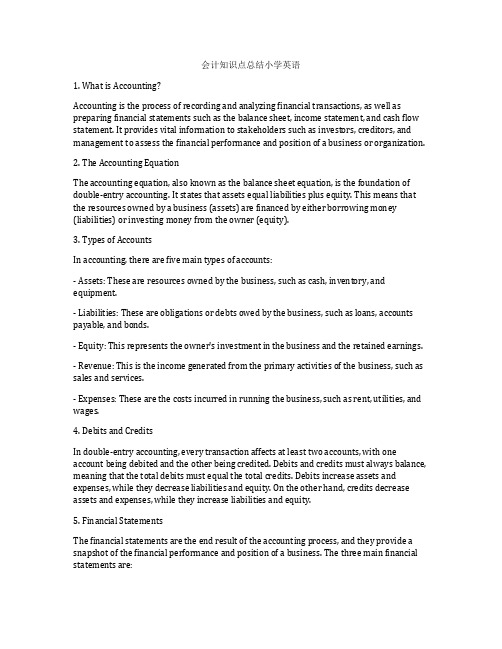
会计知识点总结小学英语1. What is Accounting?Accounting is the process of recording and analyzing financial transactions, as well as preparing financial statements such as the balance sheet, income statement, and cash flow statement. It provides vital information to stakeholders such as investors, creditors, and management to assess the financial performance and position of a business or organization.2. The Accounting EquationThe accounting equation, also known as the balance sheet equation, is the foundation of double-entry accounting. It states that assets equal liabilities plus equity. This means that the resources owned by a business (assets) are financed by either borrowing money (liabilities) or investing money from the owner (equity).3. Types of AccountsIn accounting, there are five main types of accounts:- Assets: These are resources owned by the business, such as cash, inventory, and equipment.- Liabilities: These are obligations or debts owed by the business, such as loans, accounts payable, and bonds.- Equity: This represents the owner's investment in the business and the retained earnings. - Revenue: This is the income generated from the primary activities of the business, such as sales and services.- Expenses: These are the costs incurred in running the business, such as rent, utilities, and wages.4. Debits and CreditsIn double-entry accounting, every transaction affects at least two accounts, with one account being debited and the other being credited. Debits and credits must always balance, meaning that the total debits must equal the total credits. Debits increase assets and expenses, while they decrease liabilities and equity. On the other hand, credits decrease assets and expenses, while they increase liabilities and equity.5. Financial StatementsThe financial statements are the end result of the accounting process, and they provide a snapshot of the financial performance and position of a business. The three main financial statements are:- Balance Sheet: This shows the assets, liabilities, and equity of a business at a specific point in time.- Income Statement: This shows the revenue and expenses of a business over a period, resulting in the net income or net loss.- Cash Flow Statement: This shows the cash inflows and outflows from operating, investing, and financing activities, and it helps to assess the cash position of a business.6. Accounting PrinciplesThere are several accounting principles that guide the preparation of financial statements and ensure consistency and accuracy in financial reporting. Some of the key accounting principles include:- Going Concern: This principle assumes that a business will continue to operate indefinitely, which allows assets to be valued at their historical cost rather than their liquidation value.- Revenue Recognition: This principle dictates when and how to record revenue, such as when it is earned and realizable.- Matching Principle: This principle requires that expenses should be recognized in the same period as the revenue they help generate, ensuring that the income statement accurately reflects the profitability of the business.7. Importance of AccountingAccounting is important for several reasons:- It provides crucial information for decision-making, such as whether to invest in a business or grant a loan.- It helps to monitor the financial performance and position of a business, enabling management to make informed decisions for growth and profitability.- It ensures compliance with legal and regulatory requirements, such as tax laws and financial reporting standards.In conclusion, accounting is an essential part of the business world, and it is important for students to understand its basic concepts and principles. By learning about accounting, students can gain a better understanding of financial literacy and develop the skills needed to manage their own finances in the future.。
会计英文常用词汇
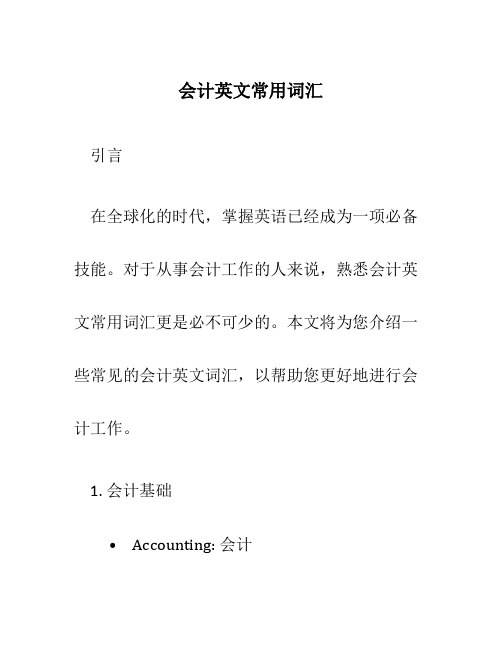
会计英文常用词汇引言在全球化的时代,掌握英语已经成为一项必备技能。
对于从事会计工作的人来说,熟悉会计英文常用词汇更是必不可少的。
本文将为您介绍一些常见的会计英文词汇,以帮助您更好地进行会计工作。
1. 会计基础•Accounting: 会计•Bookkeeping: 簿记•Assets: 资产•Liabilities: 负债•Equity: 权益•Income: 收入•Expenses: 费用•Ledger: 分类账•Balance sheet: 资产负债表•Income statement: 损益表•Cash flow statement: 现金流量表•Trial balance: 试算表•Double-entry accounting: 复式记账2. 账户类型•Cash: 现金•Accounts receivable: 应收账款•Accounts payable: 应付账款•Inventory: 存货•Fixed assets: 固定资产•Intangible assets: 无形资产•Equity or Owner’s equity: 所有者权益•Retned earnings: 留存收益•Revenue: 收益•Expense: 费用•Cost of goods sold: 销售成本3. 交易和记录•Journal entry: 日志记录•Debit: 借方•Credit: 贷方•General ledger: 总分类账•Accounts receivable ledger: 应收账款分类账•Accounts payable ledger: 应付账款分类账•Cash disbursements journal: 现金支付日记账•Cash receipts journal: 现金收款日记账•Sales journal: 销售日记账•Purchase journal: 采购日记账•General journal: 总记账簿•Posting: 记账•Trial balance: 试算表4. 税务相关•Tax: 税收•Income tax: 所得税•Sales tax: 销售税•Value-added tax (VAT): 增值税•Tax return: 纳税申报表•Tax deduction: 税务减免•Tax evasion: 逃税•Tax audit: 税务审计•Taxable income: 应纳税所得额5. 财务报告•Financial statement: 财务报表•Balance sheet: 资产负债表•Income statement: 损益表•Cash flow statement: 现金流量表•Statement of retned earnings: 公积金变动表•Financial ratios: 财务比率•Profit margin: 利润率•Return on investment (ROI): 投资回报率•Earnings per share (EPS): 每股收益•Interest coverage ratio: 利息偿付倍数结论以上是一些最常用的会计英文词汇,掌握这些词汇将有助于您更好地理解和运用英语进行会计工作。
国外会计知识点归纳总结

国外会计知识点归纳总结1. 财务会计财务会计是会计学最基础也是最重要的一个领域。
它涉及到企业的资产、负债、收入和支出等方面的记录和报告。
在国外,财务会计主要遵循国际财务报告准则(IFRS)或美国通用会计准则(GAAP)。
财务会计的知识点包括但不限于:- 会计凭证:包括借记凭证和贷记凭证的记账原则和技巧;- 账务处理:包括资产、负债、所有者权益、收入和支出等账务处理方法;- 财务报表:包括资产负债表、利润表和现金流量表等财务报表的编制方法和分析技巧;- 财务分析:包括比率分析、趋势分析和财务健康状况评估等财务分析工具和方法。
2. 成本会计成本会计是主要用于企业内部管理的一种会计方法。
它主要用于计算产品或服务的成本,并为企业的经营决策提供依据。
在国外,成本会计主要包括以下知识点:- 成本核算方法:包括作业成本法、过程成本法和标准成本法等成本核算方法的原理和应用;- 作业成本及制造费用:包括直接材料成本、直接人工成本和制造费用等企业生产成本的核算方法;- 作业成本体系:包括作业成本卡和作业成本表等成本核算工具的设计和应用;- 标准成本体系:包括标准成本的制定、执行和分析等标准成本体系的管理方法。
3. 税务会计税务会计是企业遵守税法规定,并进行税务核算和申报的一种会计方法。
在国外,税务会计与财务会计和成本会计有着密切的联系。
税务会计的知识点包括但不限于:- 税务法规:包括企业所得税法、增值税法和个人所得税法等税法的规定和适用;- 税务申报:包括企业税务申报表的编制和填报,以及税务稽查和复核等税务申报流程的管理;- 税务规划:包括税务筹划和避税规避等税务规划方法和技巧;- 跨境税务:包括跨国企业税务管理和转移定价等跨境税务规定和应对措施。
总之,在国外,会计知识点的学习和应用对企业的经营管理和个人的财务规划都至关重要。
希望通过本文的总结,读者能够对国外会计知识点有一个更清晰的认识,并能够在实际工作和生活中加以应用。
西方会计学知识点归纳总结

西方会计学知识点归纳总结会计学是一门研究如何记录、分析和报告财务交易的学科。
它在商业世界中起着至关重要的作用,为企业和个人提供了各种财务信息。
西方会计学是会计学的一个重要分支,它主要关注美国和欧洲等西方经济体的会计准则和实践。
本文将对一些西方会计学中的重要知识点进行归纳和总结。
1. 财务报表财务报表是会计学中最基本的概念之一。
它由资产负债表、利润表和现金流量表组成。
资产负债表反映了企业在特定日期的资产、负债和股东权益的情况。
利润表显示了企业在一定时期内的收入、费用和利润情况。
现金流量表记录了企业在一定时期内的现金流入和流出情况。
2. 会计准则会计准则是规范会计实践的原则和理念。
国际会计准则委员会(IASB)制定了国际财务报告准则(IFRS),它被许多国家和地区采纳。
美国则采用了美国财务会计准则(GAAP)。
这些准则为公司制定了一套标准的会计规则和程序,确保了财务报表的准确性和可比性。
3. 会计方程会计方程是会计核算中的基本原则。
它表达了资产、负债和所有者权益之间的关系,即“资产=负债+所有者权益”。
这个方程要求财务报表中的所有交易都要遵循会计方程的平衡原则。
4. 会计分录会计分录是将财务交易记录在会计账簿中的过程。
每一笔交易都需要编制相应的会计分录,以记录该交易对财务状况和财务报表的影响。
会计分录通常包括账户名称、金额和交易类型。
5. 会计周期会计周期是指进行会计核算和编制财务报表的时间段。
常见的会计周期包括月度、季度和年度。
每个周期结束时,企业需要进行结账和汇总,以便编制准确和可靠的财务报表。
6. 账户分类账户分类是将财务交易按照性质和目的进行归类的过程。
常见的账户分类包括资产、负债、所有者权益、收入和费用。
正确的账户分类可以为企业提供准确的财务信息,并帮助管理者做出正确的决策。
7. 记账方法记账方法主要包括现金基础会计和权责发生制会计。
现金基础会计是在现金收付时记录交易,适用于小型企业和个人财务。
会计专业英语词汇
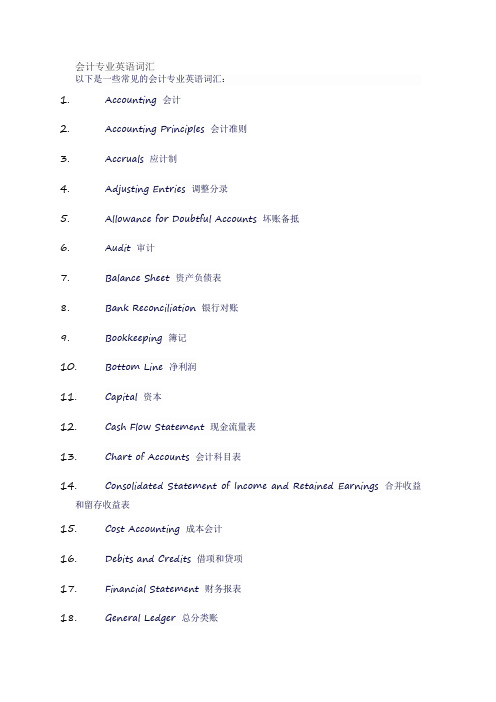
会计专业英语词汇以下是一些常见的会计专业英语词汇:1.Accounting 会计2.Accounting Principles 会计准则3.Accruals 应计制4.Adjusting Entries 调整分录5.Allowance for Doubtful Accounts 坏账备抵6.Audit 审计7.Balance Sheet 资产负债表8.Bank Reconciliation 银行对账9.Bookkeeping 簿记10.Bottom Line 净利润11.Capital 资本12.Cash Flow Statement 现金流量表13.Chart of Accounts 会计科目表14.Consolidated Statement of Income and Retained Earnings 合并收益和留存收益表15.Cost Accounting 成本会计16.Debits and Credits 借项和贷项17.Financial Statement 财务报表18.General Ledger 总分类账19.Income Statement 利润表20.Journal Entries 日记账分录21.Ledger 分户账22.Management Accounting 管理会计23.Payroll Accounting 工薪会计24.Trial Balance 试算表25.Transaction 交易26.Variance Analysis 方差分析27.Worksheet 工作底稿28.Year-End Close 年终结算29.Asset 资产30.Liability 负债31.Owner's Equity 所有者权益32.Revenue 收入33.Expense 费用34.Depreciation 折旧35.Income Statement 利润表36.Balance Sheet 资产负债表37.Statement of Owner's Equity 所有者权益表。
会计有关英文知识点

会计有关英文知识点会计是一门重要的商科学科,负责记录、处理和报告财务信息。
在全球化的背景下,掌握与会计相关的英文知识点对于从事会计工作的人员来说至关重要。
本文将介绍一些与会计有关的英文知识点,帮助读者扩展自己的会计英语词汇量,提高在国际商务领域的竞争力。
1. Financial Statements(财务报表)财务报表是记录一个企业财务状况和业绩的重要文件。
主要的财务报表包括资产负债表(Balance Sheet)、利润表(Income Statement)、现金流量表(Cash Flow Statement)和所有者权益变动表(Statement of Changes in Equity)。
掌握这些财务报表的英文术语,例如Assets(资产)、Liabilities(负债)、Revenue(收入)和Expenses(费用),对于理解和分析财务报表至关重要。
2. Accounting Principles(会计准则)会计准则是会计行业遵循的规范和原则,它确保了财务信息的准确性和可比性。
全球范围内最常用的会计准则是国际财务报告准则(International Financial Reporting Standards,简称IFRS)。
例如,IFRS中对于Revenue Recognition(收入确认)和Inventory Valuation(存货估值)都有明确的规定。
了解这些会计准则的英文表达,有助于与国际企业或者国际会计师进行有效的沟通。
3. Audit(审计)审计是对财务报表进行独立、客观的评估和核实,以确定其真实性和合规性。
在全球商业环境中,英文中经常使用的审计术语包括External Audit(外部审计)和Internal Audit(内部审计)。
掌握这些术语以及与审计相关的表达,例如Auditor(审计师)和Audit Report(审计报告),是面对国际审计事务的必备技能。
4. Taxation(税务)税务是会计领域中一个重要的方面,涉及到企业和个人的纳税义务。
会计要学哪些语言知识点

会计要学哪些语言知识点会计是一门需要掌握多种语言知识点的学科。
作为一个会计专业的学生或从业者,除了基本的财务会计知识外,还需要了解其他相关领域的语言知识,以提高自己的专业素养。
下面我将介绍一些在会计领域中必须掌握的语言知识点。
首先,会计师必须熟悉财务会计的专业术语。
这些术语包括资产、负债、所有者权益、收入、费用等。
了解这些术语的定义和用途,对于正确理解和处理财务数据是至关重要的。
其次,会计人员需要了解国际会计准则。
由于全球化的进程不断加深,各国之间的贸易和投资活动日益频繁,国际会计准则的应用变得越来越重要。
掌握国际会计准则,可以更好地理解国际财务报告标准,提高与国际合作伙伴的沟通能力。
此外,会计人员应该掌握财务分析的语言。
财务分析是对财务数据进行评估和解读的过程。
会计人员需要了解利润表、资产负债表和现金流量表等财务报表,以及相关的财务指标和比率。
这些信息可以帮助会计人员对企业的财务状况进行分析,并提供决策和建议。
除了上述基本的语言知识点外,会计人员还需要了解税法和法律知识。
税法对会计工作有直接的影响,会计人员需要掌握各种税法规定,了解如何正确申报税款并避免税务风险。
此外,法律知识也是必不可少的,会计人员需要了解公司法、劳动法等相关法律规定,以确保企业的财务活动符合法律法规。
在数字化时代,会计人员还需要掌握信息技术的语言。
会计软件、电子数据处理和云计算等新技术的引入,使会计工作更加便捷高效。
会计人员需要了解这些新技术的应用和操作,以提高工作效率和准确性。
此外,良好的沟通能力也是会计人员需要掌握的语言知识点之一。
会计人员需要与公司内外的各个部门、合作伙伴和客户进行有效的沟通,确保信息的准确传递和理解。
总之,会计人员需要掌握多种语言知识点,以应对日益复杂多样化的会计工作。
除了财务会计的专业术语和国际会计准则外,还需要了解财务分析、税法、法律和信息技术等相关领域的语言知识。
此外,良好的沟通能力也是会计人员必备的技能之一。
- 1、下载文档前请自行甄别文档内容的完整性,平台不提供额外的编辑、内容补充、找答案等附加服务。
- 2、"仅部分预览"的文档,不可在线预览部分如存在完整性等问题,可反馈申请退款(可完整预览的文档不适用该条件!)。
- 3、如文档侵犯您的权益,请联系客服反馈,我们会尽快为您处理(人工客服工作时间:9:00-18:30)。
会计学主要知识点英文Accounting is a field of study that revolves around the measurement, processing, and communication of financial information. It plays a crucial role in providing information that enables decision-making, resource allocation, and performance evaluation for individuals, organizations, and governments. In this article, we will delve into the key concepts and principles of accounting.1. Fundamental Principles of AccountingIn order to understand accounting, one must first grasp its fundamental principles. These principles serve as the foundation for accurate and reliable financial reporting. The four main principles of accounting are:(a) Going Concern: This principle assumes that a business will continue to operate indefinitely, and its financial statements should be prepared on that basis.(b) Consistency: Consistency ensures that accounting practices and methods remain unchanged over time, allowingfor comparisons across different periods.(c) Materiality: Materiality refers to the significance of an item or transaction to a business's financial statements. Material items should be disclosed separately to provide accurate and relevant information.(d) Prudence: Also known as conservatism, this principle guides accountants to be cautious when recording assets, liabilities, income, and expenses. It encourages understating assets and income, while overstating liabilities and expenses, to avoid overstating profits.2. Accounting Standards and FrameworksTo ensure consistency and comparability in financial reporting, accounting standards and frameworks are established. The two main frameworks are Generally Accepted Accounting Principles (GAAP) and International Financial Reporting Standards (IFRS).GAAP is mainly followed in the United States, while IFRS is adopted by more than 120 countries worldwide. These frameworks provide guidelines on how financial statements should be prepared, presenting a common language forfinancial reporting.The standards cover various aspects of accounting, such as revenue recognition, depreciation, inventory valuation,and financial statement presentation. The adoption of these standards allows for accurate and fair reporting across different companies and countries.3. Financial StatementsFinancial statements are the end result of accounting processes. They provide a snapshot of a company's financialposition, performance, and cash flows. The three main financial statements are:(a) Balance Sheet: The balance sheet displays a company's assets, liabilities, and shareholders' equity at a specific point in time. It helps to assess a company's financial health and its ability to meet its obligations.(b) Income Statement: The income statement summarizes a company's revenues, expenses, gains, and losses over a given period of time. It outlines the company's profitability and performance during that period.(c) Cash Flow Statement: The cash flow statement tracks the inflows and outflows of cash and cash equivalents during a specific period. It discloses the cash generated from operating activities, investing activities, and financing activities.4. Types of AccountingAccounting can be broadly classified into three main types:(a) Financial Accounting: This branch of accounting focuses on the preparation and presentation of financial statements for external users, such as investors, creditors, and regulators. It aims to provide reliable information for decision-making and assessing a company's financial health.(b) Management Accounting: Management accounting isconcerned with providing information to internal users, specifically management, for planning, controlling, and decision-making purposes. It involves the preparation of budgets, cost analyses, and performance reports.(c) Auditing: Auditing involves the examination of financial statements and records to ensure they are accurate and comply with accounting standards. It is carried out by independent professionals called auditors, who provide an objective opinion on the fairness and reliability of financial statements.In conclusion, accounting is a multifaceted discipline that encompasses various principles, frameworks, and practices. It is essential for businesses, governments, and individuals to understand these key concepts and principles to ensure accurate financial reporting, informed decision-making, and transparency in the world of finance.。
